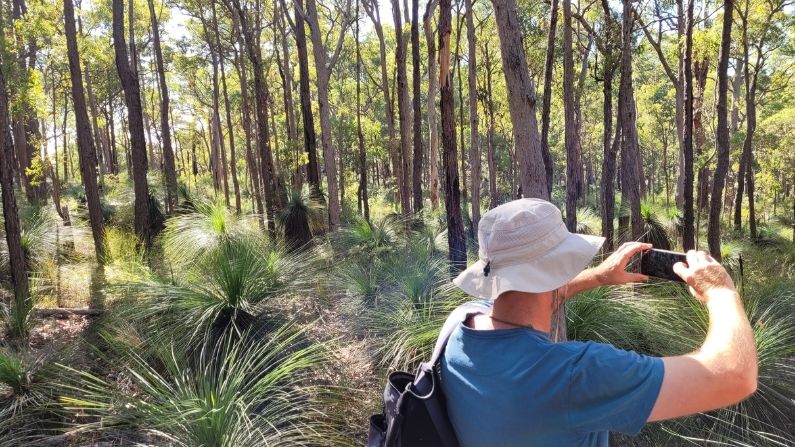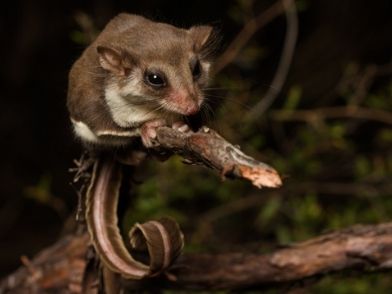Greater glider
© Jasmine Zeleny
The greater glider is Australia’s largest gliding mammal. Two morphologically and genetically distinct species are currently recognised: the northern greater glider (Petauroides minor ) north of Bowen in central Queensland, and the southern and central greater glider (Petauroides volans ) below this.
Quick facts
last updated: 5 July 2022
COMMON NAME:
Greater glider
Greater glider
SCIENTIFIC NAME:
Petauroides volans / Petauroides minor
FAMILY:
Pseudocheiridae
QLD CONSERVATION STATUS:
- Petauroides volans (southern and central greater glider): Endangered
- Petauroides minor (northern greater glider): Vulnerable
NATIONAL CONSERVATION STATUS:
- Petauroides volans (southern and central greater glider): Endangered
- Petauroides minor (northern greater glider): Vulnerable
How we help greater gliders
Through its dedicated Queensland Glider Network, Wildlife Queensland has been educating communities and raising awareness of the importance of gliders and revegetating glider habitat, installing nest boxes in areas where hollow-bearing trees are limited, implementing monitoring programs for local glider populations, and enhancing vital glider habitat.
 © Jasmine Zeleny
© Jasmine Zeleny
Did you know?
Greater gliders have adapted to feed almost exclusively on eucalyptus leaves, leading to an enlarged caecum that assists in breaking down the cellulose — much like the koala.
 © Paul Revie
© Paul Revie
Threats to greater gliders
- Habitat loss and fragmentation due to broadscale land clearing and timber-harvesting
- Climate change-induced increase in the frequency
and severity of bushfires - Predation by feral species, including dogs, cats, and foxes
- Barbed wire fences
Home range
- Generally, the home range for greater gliders is between 0.7-3 hectares and tends to have a population density of 0.01-5 individuals per hectare. The home ranges of females can overlap with males and females however for the males the home ranges never overlap.
- Natural predators in their range are large owl species, spotted-tailed quolls, goannas, and carpet pythons.
- They are known to use a large number of hollows within the home range, and they can use between 2-18 different hollows. They do not appear to build a nest as such, however, occasionally there is a lining of leaves.
Distribution
- Greater gliders occur down the east coast of Australia in Queensland, New South Wales and Victoria. They do not occur in the far north region of Queensland.
Description
- Body measurements:
- Head-body length, 350-460 mm
- Tail length, 450-600 mm
- Weight, 900-1700 grams
- Greater gliders have highly varied colouration ranging from a light grey almost white colour to a very dark sooty grey.
- The southern and central greater glider is found in three colour variations: sooty brown, grey-to-white, and silvery brown.
- The northern greater glider is brownish-grey with a pale belly.
- Greater gliders have a very long furry tail, and the most distinctive feature is their large furry ears (teddy-bear ears). Interestingly, despite being proportionally long, the tail is not prehensile.
- Unlike most gliders — such as the Australian sugar glider (Petaurus breviceps) — its gliding membranes don’t extend all the way from its wrists to its ankles. Instead, the greater glider’s gliding membrane stretches from its elbows to its ankles.
- Greater gliders can glide up to 100 metres and change direction up to 90 degrees as well.
Signs
- Considered silent and is rarely heard, however, will produce a grunt or hiss when threatened.
- Large scratches on trees from landing are also a sign to look for.
- Droppings are about the size and shape of a slightly flattened pea (5-10 mm).
- Eyes shine in an intense white colour when spotlighted and in some rare populations, the shine is a pale red colour.
Habitat
- Wide range of habitats including tall open woodland, eucalypt forests and low woodlands.
- They do not occur in rainforests.
- They prefer habitats that are in older forests and have a large number of hollows.
Ecology
Life history
- Generally, greater gliders are not considered social, however, males and females will share a den at the onset of breeding. Males usually use more den sites than females and the den sites are usually located in the centre of their home range.
Breeding
- Mating occurs between March and June. Births occur between April and June, with only 1 young per litter.
- Greater gliders only produce 1 litter per year, and they can live up to 15 years.
- Young leave the pouch at 3-4 months. Following this, for the next 3 months, they are either left at the nest or ride on the mother’s back except during glides. Young are independent at 8-10 months.
Food
- Greater gliders feed mainly on eucalypt leaves.
- They prefer young leaves due to their high levels of nitrogen and low levels of fibre
- They prefer leaves from the ribbon, mountain and narrow-leaved peppermint eucalypt tree
- They are known to feed on the buds and flowers of eucalypts
- They are also known to feed on the young cones of the radiata pine tree, phyllodes of acacia plants and even mistletoe.
More information
Publications & papers
- Cunningham, R.B., Pope, M.L., and Lindenmayer, D.B. (2004). Patch use by the greater glider (Petauroides volans) in fragmented forest ecosystem. III. Night-time use of trees. Wildlife Research, 31: 579-585.
- Eyre, T.J. (2006). Regional habitat selection of large gliding possums at forest stand and landscape scales in southern Queensland, Australia I. Greater glider (Petauroides volans). Forest Ecology and Management.
- Lindenmayer, D.B., Pope, M.L., and Cunningham, R.B. (2004). Patch use by the greater glider (Petauroides volans) in a fragmented forest ecosystem. II. Characteristics of den trees and preliminary data on den-use patterns. Wildlife Research 31: 569-577.
- McGregor, D.C., Padovan, A., Georges, A. et al. Genetic evidence supports three previously described species of greater glider, Petauroides volans, P. minor, and P. armillatus. Sci Rep 10, 19284 (2020), accessed 9 February 2021. https://doi.org/10.1038/s41598-020-76364-z Published: .
- Pope, M.L, Lindenmayer, D.B, Cunningham, R.B. (2004). Patch use by the greater glider (Petauroides voalns) in a fragmented forest ecosystem. I. Home range size and movements. Australian Wildlife Research.
- Smith, G.C, Mathieson, M. and Hogan, L. (2007). Home range and habitat use of a low-density population of greater gliders, Petauroides volans (Pseudocheiridae: Marsupialia), in a hollow-limiting environment. Australian Wildlife Research.




